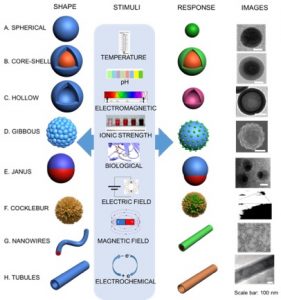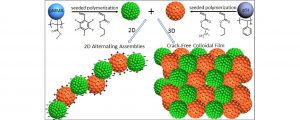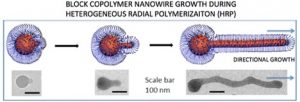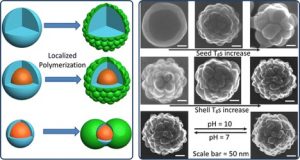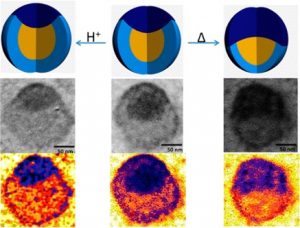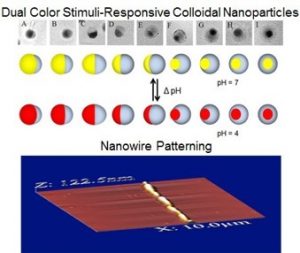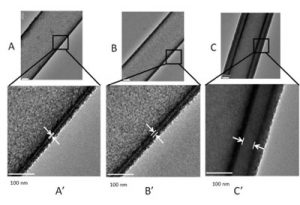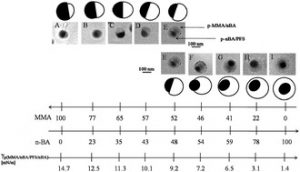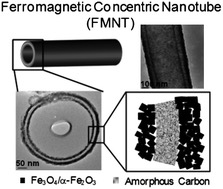C. Lu, M.W. Urban, “Stimuli-responsive polymer nano-science: shape anisotropy, responsiveness, applications” Prog. Polym. Sci., 2017, http://dx.doi.org/10.1016/ j.progpolymsci.2017.07.005Y.
ABSTRACT
Polymeric nanomaterials capable of altering volume, color, or shape have attracted significant scientific interests as these materials become increasingly critical in advancing unique technological developments. Design, synthesis, and assembly of nanomaterials with precisely controlled shapes and directional responsiveness are particularly critical in the development of new functional, near-device level materials. Spatial anisotropies are typically introduced by the placement of symmetrically or asymmetrically located responsive components enabling either interactions with the environment manifested by dimensional or color changes, energy storage and transfer, or diffusion. This review outlines recent advances in the synthesis, fabrication, and assembly of isotropic and anisotropic polymer-based nanomaterials in which dimensional, color, and morphological changes are induced by external stimuli. Specifically, core-shell, hollow, Janus, gibbous/inverse gibbous nanoparticles prepared with precisely controlled morphologies capable of spatially responding totemperature, pH, electromagnetic radiation or biological changes are discussed. Recent advances in the nanoparticle surface modifications which are introduced to guide nanomaterials to selectively interact and communicate with the environment are also highlighted. Since high aspect ratio nanomaterials, including polymeric nanowires or nanotubes containing responsive components, are particularly attractive in the development of 3D multi-functional objects, their manufacturing as well as applications are examined. Although many uses of stimuli-responsive nanomaterials in electronics, energy conversion, sensing, or biomedicine and other technologies are already in place, there are limitless opportunities for new applications as long as proper regulatory measures are exercised to elevate the impact of these materials on the environment. Polymeric stimuli responsive nanomaterials offer a tremendous opportunity for the development of cognitive materials’ systems, particularly when protein-like polymers containing amino acids joined by polypeptide bonds with enzymes or sugarphosphate moieties as well as other sugar-containing interactions are utilized as building blocks and components of future materials.
C. Lu, M.W. Urban, “Synthesis and Directional Assembly of Gibbous and Inverse-Gibbous Colloidal Nanoparticles” Mater. Today, 2016, 9, 41-46.
ABSTRACT
Due to the absence of anisotropic directional bonds, one of the intriguing aspects of nanoparticle structural organizations is encoding directionally guided arrays. Although van der Waals, electrostatic interactions and geometrical matching were proposed, a controllable assembly of isotropic shapes still remains to be a challenge. These studies show the synthesis of gibbous/inverse-gibbous colloidal nanoparticles that utilized hydrophobic and hydrophilic environments during aqueous emulsion polymerization resulting in the formation of opposite shape matching surface topographies. The topography-matching nanoparticles stabilized by opposite charges are capable of forming directional assemblies facilitated by electrostatic forces and mechanical interlocking. As a result, combining gibbous and inverse-gibbous nanoparticles results in the formation of 2D directional arrays. When the same nanoparticles are deposited on a surface, crack-and defect-free colloidal morphologies develop which form face-center-cubicle (fcc) colloidal assemblies with highest packing densities.
C. Lu, M.W. Urban. “Instantaneous Directional Growth of Block Copolymer Nanowires During Heterogeneous Radical Polymerization (HRP)” Nano Lett., 2016, 4, 2873-2877.
ABSTRACT
Polymeric nanowires that consist of ultrahigh molecular weight block copolymers were instantaneously prepared via one-step surfactant-free heterogeneous radical polymerization (HRP). Under heterogeneous reaction and initiator-starvation conditions, the sequential copolymerization of hydrophilic and hydrophobic monomers facilitates the formation of amphiphilic ultrahigh molecular weight block copolymers, which instantaneously assemble to polymeric nanowires. As polymerization progresses, initially formed nanoparticles exhibit the directional growth due to localized repulsive forces of hydrophilic blocks and confinement of the hydrophobic blocks that adopt favorable high aspect ratio nanowire morphologies. Using one-step synthetic approach that requires only four ingredients (water as a solvent, two polymerizable monomers (one hydrophilic and one hydrophobic), and water-soluble initiator), block copolymer nanowires ∼70 nm in diameter and hundreds of microns in length are instantaneously grown. For example, when 2-(N,N-dimethylamino)ethyl methacrylate (DMAEMA) and styrene (St) were copolymerized, high aspect ratio nanowires consist of ultrahigh (>106 g/mol) molecular weight pDMAEMA-b-St block copolymers and the presence of temperature responsive pDMAEMA blocks facilitates nanowire diameter changes as a function of temperature. These morphologies may serve as structural components of the higher order biological constructs at micro and larger length scales, ranging from single strand nanowires to engineered biomolecular networks capable of responding to diverse and transient environmental signals, and capable of dimensional changes triggered by external stimuli.
C. Lu, M.W. Urban, “One-Step Synthesis of Amphiphilic Ultrahigh Molecular Weight Block Copolymers by Surfactant-Free Heterogeneous Radical Polymerization” ACS Macro Lett., 2015, 4, 1317-1320.
ABSTRACT
Ultrahigh molecular weight (>106 g/mol) amphiphilic block copolymers were synthesized using one-step surfactant-free heterogeneous radical polymerization (SFHRP). The polymerization initially involves formation of water-soluble homopolymer blocks, followed by copolymerization of a hydrophobic monomer, resulting in ultrahigh molecular weight block copolymers. Facilitating heterogeneous reaction conditions and continuous supply of an initiator controls the process. Using this synthetic approach, we synthesized amphiphilic block copolymers of poly(2-(N,N-dimethylamino)ethyl methacrylate)-block-poly(n-butyl acrylate) (pDMAEMA-b-pnBA), pDMAEMA-block-p(tert-butyl acrylate) (pDMAEMA-b-tBA), and pDMAEMA-block-polystyrene (pDMAEMA-b-pSt) with molecular weights of 1.98 × 106, 1.18 × 106, and 0.91 × 106 g/mol, respectively. These ultrahigh molecular weight block copolymers can self-assemble in nonpolar solvents to form thermochromic inverse polymeric micelles as well as other shapes and exhibit many potential applications.
C. Lu, M.W. Urban, “Rationally Designed Gibbous Stimuli-Responsive Colloidal Nanoparticles,” ACS Nano, 2015, 9, 3119-3124.
ABSTRACT
Multiphase colloidal copolymer nanoparticles, if properly designed, offer a number of unique properties and well-documented technological opportunities for drug delivery, nanolithography, high surface area colloidal crystals, or hollow nanoparticles, to name just a few. Using a simple free radical polymerization process, we synthesized copolymer nanoparticles with controlled stimuli-responsive phase-separated gibbosities. The topography of the gibbous phase can be controlled by the copolymer composition and polymerization conditions. When pH-sensitive monomers were copolymerized onto surface bulges, pH changes resulted in localized gibbous phase dimensional changes. Facilitated by monomer diffusion into interfacial particle seed solution regions, localized polymerization near the surface is responsible for the formation of phase-separated gibbous topographies. This general approach may offer a number of possibilities for controllable design of ordered heterogeneous copolymer morphologies for a variety of applications.
C. Lu, M. W. Urban, “Tri-Phasic Size- and Janus Balance-Tunable Colloidal Nanoparticles (JNPs)” ACS Macro Lett., 2014, 3,346-352.
ABSTRACT
These studies show synthesis of triphasic size- and Janus balance (JB)-tunable nanoparticles (JNPs) utilizing a two-step emulsion polymerization of pentafluorostyrene (PFS) and 2-(dimethylamino)ethyl methacrylate (DMAEMA) and n-butyl acrylate (nBA) in the presence of poly(methyl methacrylate (MMA)/nBA) nanoparticle seeds. Each JNP consists of three phase-separated copolymers: p(MMA/nBA) core, temperature, and pH-responsive (p(DMAEMA/nBA)) phase capable of reversible size and shape changes, and shape-adoptable (p(PFS/nBA)) phase. Due to built-in second-order lower critical solution temperature (II-LCST) transition of p(DMAEMA/nBA) copolymer, macromolecular segments collapse when temperature increases from 30 to 45 °C, resulting in size and shape changes. The p(DMAEMA/nBA) and p(MMA/nBA) phases within each JNP assume concave, flat, or convex shapes, forcing p(PFS/nBA) phase to adopt convex, planar, or concave interfacial curvatures, respectively. As a result, the JB can be tuned from 3.78 to 0.72. The presence of pH-responsive DMAEMA component also facilitates the size and JB changes due to protonation of the tertiary amine groups of p(DMAEMA/nBA) backbone. Synthesized in this manner, JNPs are capable of stabilizing oil droplets in water at high pH to form Pickering emulsions, which at lower pH values release oil phase. This process is reversible and can be repeated many times.
D. Ramachandran, C. C. Corten, M. W. Urban, “Color- and shape-tunable colloidal nanoparticles capable of nanopatterning” RSC Adv.,2013, 3, 9357-9364.
ABSTRACT
Color- and shape-tunable nanoparticles consisting of phase-separated copolymers within each particle were synthesized using emulsion copolymerization synthesis. Each particle consists of two phases: (1) poly(methyl methacrylate/n-butyl acrylate) (p(MMA/nBA)) phase, which is responsible for a particle shape control, and (2) poly(n-butylacrylate/pentafluorostyrene/N,N-dimethyl aminoazoaniline methacrylate) (p(nBA/PFS/DMAAZOAMm)) phase, facilitating tunable color changes and fluorescence emission induced by acidic/basic environments. Since these particles are capable of coalescence, these studies also show simple nano-deposition process will result in ∼200-300 nm width nanowires with “polka-dot” morphologies, offering many diversified applications ranging from high-resolution inexpensive display technologies to nano-sensing devices, or multi-drug and multi-transient delivery systems.
M. Yu, M.W. Urban, “Ferromagnetic Nanotubes Formation; Length and Thickness Control” J. Mater. Chem. C, 2013, 1(9), 1863-1869.
ABSTRACT
Although magnetic nanotubes exhibit many potential applications ranging from drug or gene delivery to bioseparation, catalysis, electromagnetic or magneto-optic devices, and many others, their developments are at relatively infant stages. Recently, we utilized biologically active phospholipids (PLs) as templates to produce ferromagnetic magnetite/carbon/magnetite concentric nanotubes (FMNTs) in which simple synthetic efforts resulted in the formation of an electrically conductive carbon layer sandwiched between ferromagnetic magnetite phases, thus offering magnetic and electric attributes combined in one nanotube. Since the geometry and size of each of the FMNT components are critical factors in controlling desirable magnetic and electrical properties, control of the wall thickness as well as the diameter and length is of particular interest. This study reports the development of a simple synthetic approach to control the geometry of FMNTs by changing the concentration levels of the reactants and solvent conditions. Using this approach we synthesized concentric carbon-magnetite nanotubes with a variable thickness of 6, 10, and 60 nm conductive carbon layers and 12 to 45 nm magnetic magnetite layers. As a result, saturation magnetization values could be incrementally tuned from 40 to 79 emu g−1.
C.C. Corten, M.W. Urban, “Shape Evolution Control of Phase-separated Colloidal Nanoparticles” Polym. Chem., 2011, 2, 244-250.
ABSTRACT
These studies illustrate controlled shape synthesis of two distinct phase-separated copolymers within one colloidal nanoparticle which consists of poly(methyl methacrylate) (p-MMA)/n-butyl acrylate (nBA) and poly(nBA)/pentafluorostyrene (p-PFS) phases. Using sequential free radical polymerization, particle morphologies ranging from acorn to ellipsoidal, core–shell, and spherical were produced by adjusting the glass transition temperature (Tg) via compositional gradients during copolymerization. These studies show for the first time that in order to achieve desirable asymmetric particle shapes, the Tg as well as interfacial surface tension between two copolymers within one nanoparticle should be maintained during and after polymerization.
M. Yu, J. Howe, K. Jeong, I. Shim, W. Kim, C. Kim, J. Ahn, J. Lee, M.W. Urban, “Structural and Morphological Features of Concentric Iron Oxide/Carbon Nanotubes Obtained from Phospholipids” J. Mater. Chem., 2010, 20(27), 5748–5755.
ABSTRACT
Biologically active 1,2-bis(10,12-tricosadiynoyl)-sn-glycero-3 phosphocholine (DC8,9PC) nanotube-forming phospholipids (PLs) have been utilized as templates to prepare ferromagnetic nanotubes (FMNTs). Combining X-ray diffraction (XRD), selected area electron diffraction (SAD), high-resolution transmission electron microscopy (HRTEM), Raman, and Mössbauer spectroscopy measurements, FMNTs morphological features and chemical composition were determined. These studies showed that FMNTs consist of iron oxide/carbon/iron oxide concentric nanotubes with the amorphous carbon phase sandwiched between two iron oxide layers. The iron oxide phase consists of nanocrystalline magnetite (Fe3O4) which coexist as tetrahedral Fe3+ and octahedral Fe2.5+ sites containing minute quantities of hematite (α-Fe2O3) phase. The carbon phase consists of amorphous carbon forming an amorphous carbon nanotube (ACNT). Magnetic measurements showed that saturation magnetization (Ms) of FMNTs is 79 emu/g, but upon removal of the iron oxide outer and inner layers, ACNTs become paramagnetic. The electrical resistivity (ρ) of single FMNT is 3.3 × 10−2 Ω·m, which decreases to 5.06 × 10−4 Ω·m for ACNT. These magneto-electric properties can be easily tailored, depending upon desired applications and needs.

